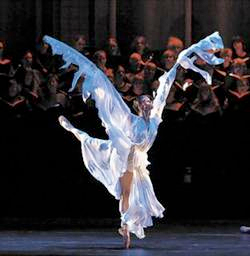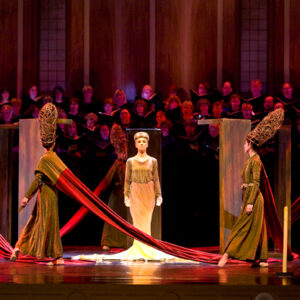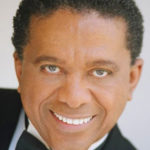
Carmina Burana June 2008
Medieval musing and massing : Impressive merger brought Carmina Burana to life Saturday at The Granada
JOSEF WOODARD, NEWS-PRESS CORRESPONDENT
June 2, 2008 7:23 AM

State Street Ballet and Santa Barbara Choral Society brought William Soleau’s choreography for “Carmina Burana” to The Granada on Saturday, featuring Victoria Luchkina, left, as the Swan. It was another Saturday night in the lavishly rebirthed Granada theater. This time out, we had the first convergence of choreography, choral and orchestral forces — not to mention the first real vintage erotic and heretical content onstage — courtesy of Carl Orff’s “Carmina Burana.” With new choreography by William Soleau for the nimble State Street Ballet, and massive instrumental and vocal music by the Santa Barbara Choral Society, this was a full evening, on many levels.
Jo Anne Wasserman, director of the Choral Society, acquitted herself nicely this evening, with her hands and The Granada stage more than full. Before the Orff opus consumed the concert’s second half, Ms. Wasserman paid a friendly visit to other agreeable music from the 20th century. Aaron Copland’s “Fanfare for the Common Man” was an almost too obvious choice for an appetizer, but in effect, Leonard Bernstein’s grand “Chichester Psalms” served in a secondary and inspirational, venue-warming fanfare role here.
In The Granada, countertenor Beau Palmer was a dazzling soloist, and the chorale summoned precision, passion and grandeur, to suit. Basing his work on a collection of Medieval poems discovered in a Bavarian monastery in 1803, Orff finished his large, accessible oratorio in 1936, and it has become a regular, if also an ensemble-challenging part of the choral-orchestral canon. In part, its popularity has to do with the accessibility of Orff’s musical language, which grazes past “difficult” Modernist aspects more as coloration than substance.
From the textual side of things, “Carmina Burana” includes drinking songs, lusty songs and cautionary tales about the foibles of humanity, which are relatively calendar proof, relevant in the 13th century as well as the 21st. That makes “Carmina” an earthier diversion in a choral repertoire thickly populated with more staid liturgical texts.

Seeing “Carmina,” with an elaborate dance element at the center, seemed odd to those accustomed to Orff’s music being presented as music for music’s sake. In fact, though, the big and theatrically minded Orff originally hoped for multi-sensory productions that would include dance, staging and other appeals to senses beyond sound on a concert stage.
For the Orff affair, the chorale lined the back of the stage, and soloists — soprano Lori Stinson, tenor Beau Palmer (dropping down into the “male” register) and baritone Paul Sahuc — appeared on the front-side stage in costume. The orchestra was sent to the pit to free up the stage for dance.
Mr. Soleau’s flowing choreographic scheme began in The Granada’s house, as monk-like dancers descended down the aisles and on to the stage, working around a few spare, effective props. Nothing particularly racy or adventurous unveiled through the choreography, which moved fluidly and sometimes to a fault, for a piece in which heresy and overheated libidos are embedded in the text. Then again, Orff’s music addresses such rough stuff gingerly, compared to, say, Stravinsky’s mythic gusto in “Rite of Spring.”
As the music rounded the corner into “O Fortuna,” the lusty, lofty and familiar final theme, the sound quickly worked its way from a sententious murmur to an angular wail to close the piece. Dark-hooded monks lurked about the stage during the muted section. When the music flung itself open to rowdier spirits, the dancers dramatically disrobed to reveal both sexes dressed in all-white garb, making antic motions around the fateful lovers in the center. The wheel of fortune theme came full circle, so to speak.

 American baritone, Ralph Cato has travelled the world extensively, telling stories in song with his warm, clarion baritone voice.
American baritone, Ralph Cato has travelled the world extensively, telling stories in song with his warm, clarion baritone voice. Tenor, Benjamin Brecher has performed over fifty operatic roles with many of the world’s most prestigious opera companies, specializing in the high lying lyric tenor repertoire. He has performed 16 roles with New York City Opera alone. Career highlights include performances with Opera Orchestra of New York, L’Opera de Nice, Rossini Opera Festival in Pesaro, L’Opera de Montreal, Santa Fe Opera, Opera Theatre of St. Louis, among many others. His orchestral solo repertoire includes Mozart, Handel, Orff, Bach, Haydn, as well as many performances of Britten. In 2000 he began performing the great Irish Tenor songs in a concert produced for him entitled A Celtic Celebration, Twenty years later, the show has become a North American hit with performances with 45 Symphonies in North America. Ben continues his discography having added his twelfth recording in 2016 Forgotten Liszt, with pianist Robert Koenig, and will record a new release in 2022 entitled “Three Centuries of Thomas Moore” including the music of Britten, Berlioz, and Sarah Gibson on MSR Classics. He is a Professor of Voice at University of California Santa Barbara, where he has served as the Head of Voice.
Tenor, Benjamin Brecher has performed over fifty operatic roles with many of the world’s most prestigious opera companies, specializing in the high lying lyric tenor repertoire. He has performed 16 roles with New York City Opera alone. Career highlights include performances with Opera Orchestra of New York, L’Opera de Nice, Rossini Opera Festival in Pesaro, L’Opera de Montreal, Santa Fe Opera, Opera Theatre of St. Louis, among many others. His orchestral solo repertoire includes Mozart, Handel, Orff, Bach, Haydn, as well as many performances of Britten. In 2000 he began performing the great Irish Tenor songs in a concert produced for him entitled A Celtic Celebration, Twenty years later, the show has become a North American hit with performances with 45 Symphonies in North America. Ben continues his discography having added his twelfth recording in 2016 Forgotten Liszt, with pianist Robert Koenig, and will record a new release in 2022 entitled “Three Centuries of Thomas Moore” including the music of Britten, Berlioz, and Sarah Gibson on MSR Classics. He is a Professor of Voice at University of California Santa Barbara, where he has served as the Head of Voice. Born and raised in Southern California, April Amante is a versatile soprano with expertise and facility in repertoire spanning from early music to contemporary musical theater.
Born and raised in Southern California, April Amante is a versatile soprano with expertise and facility in repertoire spanning from early music to contemporary musical theater. Tracy Van Fleet is pleased to return to the Santa Barbara Choral Society. As a soloist, she has performed with the Los Angeles Master Chorale, Lüneburg Symphony in Germany, Orquesta Filarmónica de Boca del Río in Mexico, Pasadena Symphony, Naples Philharmonic, Los Angeles Bach Festival, San Diego Chamber Orchestra, Colorado Philharmonic, USC Symphony and Chorus, and others. She has had many appearances with the Los Angeles Opera, Los Angeles Philharmonic, Pacific Symphony, Hollywood Bowl Orchestra, Opera Pacific, San Diego Opera and Opera Colorado.
Tracy Van Fleet is pleased to return to the Santa Barbara Choral Society. As a soloist, she has performed with the Los Angeles Master Chorale, Lüneburg Symphony in Germany, Orquesta Filarmónica de Boca del Río in Mexico, Pasadena Symphony, Naples Philharmonic, Los Angeles Bach Festival, San Diego Chamber Orchestra, Colorado Philharmonic, USC Symphony and Chorus, and others. She has had many appearances with the Los Angeles Opera, Los Angeles Philharmonic, Pacific Symphony, Hollywood Bowl Orchestra, Opera Pacific, San Diego Opera and Opera Colorado.